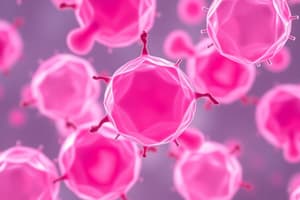Podcast
Questions and Answers
What is a common clinical presentation in symptomatic patients with lymphadenopathy?
What is a common clinical presentation in symptomatic patients with lymphadenopathy?
- Elevated blood pressure
- Increased appetite
- Weight loss (correct)
- Mood swings
Which factor is correlated with a better outcome in patients with CLL/SLL?
Which factor is correlated with a better outcome in patients with CLL/SLL?
- Deletions of 11q
- Presence of NOTCH1 mutations
- Somatic hypermutation (correct)
- High expression of ZAP-70
What is the typical leukocyte count range in patients with CLL who have heavy tumor burdens?
What is the typical leukocyte count range in patients with CLL who have heavy tumor burdens?
- Less than 5,000 cells/µL
- In excess of 200,000 cells/µL (correct)
- Between 10,000 and 25,000 cells/µL
- Between 50,000 and 100,000 cells/µL
Which of the following is a common complication in patients with hypogammaglobulinemia?
Which of the following is a common complication in patients with hypogammaglobulinemia?
What is the overall median survival for patients diagnosed with CLL/SLL?
What is the overall median survival for patients diagnosed with CLL/SLL?
What does the presence of spherocytes in an autoimmune hemolytic anemia indicate?
What does the presence of spherocytes in an autoimmune hemolytic anemia indicate?
Which immunophenotype markers are typically expressed in CLL/SLL?
Which immunophenotype markers are typically expressed in CLL/SLL?
What molecular anomaly is commonly associated with CLL/SLL?
What molecular anomaly is commonly associated with CLL/SLL?
What is the typical presenting symptom in patients diagnosed with CLL/SLL?
What is the typical presenting symptom in patients diagnosed with CLL/SLL?
What role does Nuclear Factor Kappa B (NF-KB) play in the pathology of CLL/SLL?
What role does Nuclear Factor Kappa B (NF-KB) play in the pathology of CLL/SLL?
What type of nucleated cells might be seen in cases of severe anemia?
What type of nucleated cells might be seen in cases of severe anemia?
What is a distinctive feature of the tumor cells in CLL/SLL seen at higher magnification?
What is a distinctive feature of the tumor cells in CLL/SLL seen at higher magnification?
What typically initiates the proliferation of CLL/SLL cells?
What typically initiates the proliferation of CLL/SLL cells?
What percentage of solitary myeloma cases typically present as a solitary lesion of bone or soft tissue?
What percentage of solitary myeloma cases typically present as a solitary lesion of bone or soft tissue?
Where do extraosseous lesions in solitary myeloma usually occur?
Where do extraosseous lesions in solitary myeloma usually occur?
What is the likely outcome for solitary osseous plasmacytoma if left untreated?
What is the likely outcome for solitary osseous plasmacytoma if left untreated?
Which condition serves as a middle ground between multiple myeloma and MGUS?
Which condition serves as a middle ground between multiple myeloma and MGUS?
What is the serum M protein level indicative of smoldering myeloma?
What is the serum M protein level indicative of smoldering myeloma?
What percentage of patients with smoldering myeloma progress to multiple myeloma over 15 years?
What percentage of patients with smoldering myeloma progress to multiple myeloma over 15 years?
What could be a characteristic of Igs produced in solitary myeloma cases?
What could be a characteristic of Igs produced in solitary myeloma cases?
What is true concerning the suppression of normal humoral immunity in solitary myeloma?
What is true concerning the suppression of normal humoral immunity in solitary myeloma?
What is the characteristic feature of Burkitt lymphomas regarding the MYC gene?
What is the characteristic feature of Burkitt lymphomas regarding the MYC gene?
Which protein is always NOT expressed in DLBCL specimens?
Which protein is always NOT expressed in DLBCL specimens?
What type of immunophenotype is typically expressed in Burkitt lymphomas?
What type of immunophenotype is typically expressed in Burkitt lymphomas?
What characteristic cell population is notably absent in Burkitt lymphomas?
What characteristic cell population is notably absent in Burkitt lymphomas?
What demographic is primarily affected by Burkitt lymphomas?
What demographic is primarily affected by Burkitt lymphomas?
What response to chemotherapy is typical for Burkitt lymphomas?
What response to chemotherapy is typical for Burkitt lymphomas?
Which immunophenotype marker is NOT associated with Burkitt lymphomas?
Which immunophenotype marker is NOT associated with Burkitt lymphomas?
What is the typical surface immunoglobulin expression in Burkitt lymphoma?
What is the typical surface immunoglobulin expression in Burkitt lymphoma?
Which characteristic is associated with the cytological features of Burkitt lymphoma?
Which characteristic is associated with the cytological features of Burkitt lymphoma?
Which chromosome contains the c-MYC gene that is often translocated in Burkitt lymphoma?
Which chromosome contains the c-MYC gene that is often translocated in Burkitt lymphoma?
What type of cells are primarily involved in Hairy Cell Leukemia?
What type of cells are primarily involved in Hairy Cell Leukemia?
Which immunophenotype marker is commonly expressed in Hairy Cell Leukemia?
Which immunophenotype marker is commonly expressed in Hairy Cell Leukemia?
What is a significant clinical feature of Multiple Myeloma related to bone health?
What is a significant clinical feature of Multiple Myeloma related to bone health?
A critical cytokine for the proliferation and survival of myeloma cells is?
A critical cytokine for the proliferation and survival of myeloma cells is?
The genetic mutations associated with most cases of Hairy Cell Leukemia occur in which gene?
The genetic mutations associated with most cases of Hairy Cell Leukemia occur in which gene?
What common physical finding is associated with Pancytopenia in Multiple Myeloma?
What common physical finding is associated with Pancytopenia in Multiple Myeloma?
What is the peak age of incidence for Multiple Myeloma?
What is the peak age of incidence for Multiple Myeloma?
Which feature of Multiple Myeloma contributes to the pathogenesis of bone destruction?
Which feature of Multiple Myeloma contributes to the pathogenesis of bone destruction?
Which of the following is NOT commonly associated with Multiple Myeloma?
Which of the following is NOT commonly associated with Multiple Myeloma?
The radiographic presentation of bone lesions in Multiple Myeloma is best described as:
The radiographic presentation of bone lesions in Multiple Myeloma is best described as:
Flashcards are hidden until you start studying
Study Notes
Solitary Myeloma (Plasmacytoma)
- 3-5% of cases present as a solitary lesion of bone or soft tissue
- Bone lesions occur in the same locations as multiple myeloma
- Extraosseous lesions occur in the lungs, oronasopharynx, or nasal sinuses
- Modest elevations of M proteins in the blood or urine may be found in some patients
- Solitary osseous plasmacytoma almost inevitably progresses to multiple myeloma, which can take 10-20 years or longer
- Extraosseous plasmacytomas involving the upper respiratory tract are frequently cured by local resection
Smoldering Myeloma
- A middle ground between multiple myeloma and monoclonal gammopathy of uncertain significance (MGUS)
- Plasma cells make up 10-30% of the marrow cellularity
- Serum M protein level is >3 g/dL but patients are asymptomatic
- About 75% of patients progress to multiple myeloma over a 15-year periods
Multiple Myeloma
- Clonal proliferation of neoplastic plasma cells in the bone marrow
- A plasma cell neoplasm commonly associated with lytic bone lesions, hypercalcemia, renal failure, and acquired immune abnormalities
- Incidence is higher in men and people of African descent
- Peak age of incidence: 65-70 years old
- Strictly a disease of older adults
- Genetically heterogeneous
- Associated with frequent rearrangements involving IGH locus on chromosome 14q32 and various proto-oncogenes
- Proliferation and survival of myeloma cells are dependent on several cytokines, most notably IL-6
- IL-6 is an important growth factor for plasma cells
- IL-6 is produced by the tumor cells themselves and resident marrow stromal cells
- High serum levels of IL-6 are seen in patients with active disease
- High serum levels of IL-6 are associated with poor prognosis
- Major pathological feature: bone destruction, which is mediated by factors produced by neoplastic plasma cells
- Myeloma-derived MIP1α, chemokine that augments osteoclast formation
- Myeloma-derived MIP1α upregulates the expression of the receptor activator of NF-kB ligand (RANKL) by bone marrow stromal cells
- Net effect: marked increase in bone resorption leading to hypercalcemia and pathologic fractures
- Modulators of the Wnt pathway are potent inhibitors of osteoblast function resulting in a net effect of marked increase in bone resorption leading to hypercalcemia and pathologic fractures
Radiographic Presentation
- Bone lesions appear radiographically as punched-out defects
- Usually about 1-4 cm in diameter
Studying That Suits You
Use AI to generate personalized quizzes and flashcards to suit your learning preferences.




